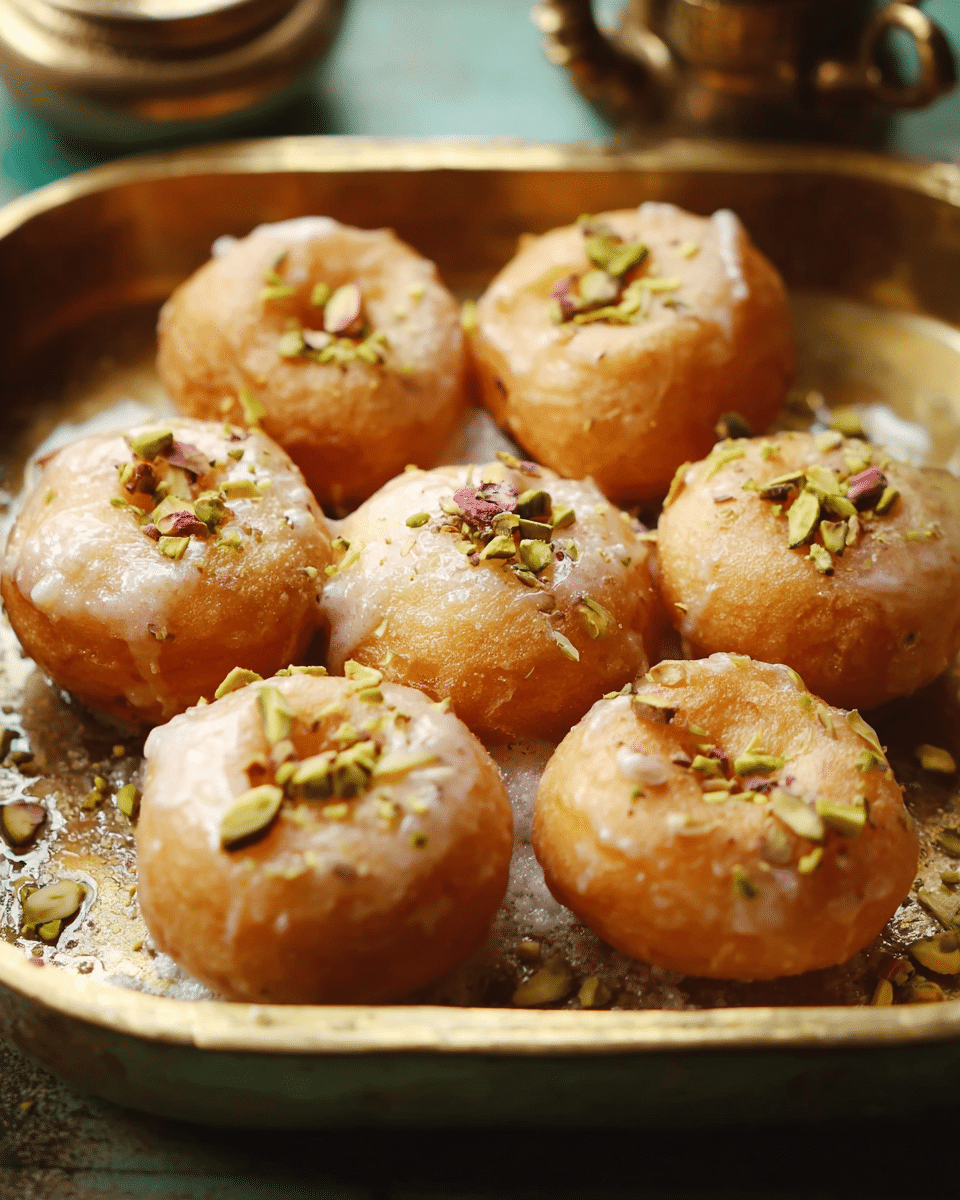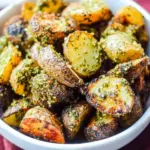Balushahi, also known as Badusha in the South, is a beloved Indian dessert that’s rich in tradition and taste. With its crisp exterior and delicately flaky interior, this sweet treat is deep-fried to golden perfection and soaked in an aromatic cardamom-infused sugar syrup. The addition of saffron lends both color and a subtle floral depth, while pistachios on top bring texture and a nutty contrast.
Unlike western donuts, Balushahi is denser and carries the indulgent depth of ghee in every bite. It’s a festive favorite during Diwali and weddings, often gracing sweet platters across homes and mithai shops. With a few basic ingredients and a bit of patience, you can recreate this halwai-style sweet right in your kitchen — a perfect tribute to India’s culinary heritage.
Full recipe:
Ingredients:
For the Dough:
-
2 cups (250g) all-purpose flour (maida)
-
¼ cup (60g) ghee, semi-solid
-
¼ cup (60g) chilled curd (dahi)
-
8 to 9 tablespoons cold water (as needed)
-
1 pinch salt
-
1 pinch baking soda
-
½ teaspoon baking powder
For the Sugar Syrup:
-
1 heaped cup (200g) sugar
-
½ cup water
-
½ to 1 teaspoon cardamom powder
-
10 to 12 saffron strands
-
2 to 3 drops lemon juice (optional)
For Frying & Garnish:
-
Oil or ghee, for deep frying
-
1 to 2 tablespoons chopped pistachios or almonds
-
Optional: dried rose petals or additional saffron strands
Directions:
-
In a mixing bowl, beat the semi-solid ghee with a whisk until light and fluffy.
-
Add the chilled curd and whisk again until smooth.
-
Sift flour directly into the creamed mixture. Add salt, baking soda, and baking powder.
-
Gently mix the flour into the ghee-curd mixture with a spoon.
-
Add cold water, a few tablespoons at a time, to form a soft dough. Do not knead—just gather it together. Let rest for 15 minutes.
-
Meanwhile, prepare sugar syrup: Combine sugar and water in a wide pan over low heat. Stir to dissolve.
-
Add cardamom powder and saffron. Optionally, add lemon juice to prevent crystallization. Simmer until syrup becomes sticky or reaches ½ to 1-string consistency. Keep warm.
-
Shape the dough into small balls and flatten gently. Make a small dent in the center of each.
-
Heat oil or ghee in a deep pan on medium heat. Test with a small dough piece—it should rise slowly.
-
Lower the heat and add 5–6 Balushahi at a time. Fry slowly on low heat for 12–15 minutes, turning occasionally, until golden brown and crisp.
-
Remove and drain on paper towels. While still warm, soak in hot sugar syrup for 14–15 minutes, flipping to coat evenly.
-
Transfer to a tray and garnish with chopped pistachios and saffron.
-
Repeat for remaining dough. Cool completely before storing.
Prep Time: 20 minutes
Cooking Time: 35 minutes
Total Time: 55 minutes
Kcal: 111 kcal per piece
Servings: 17 pieces
A Sweet with Regional Diversity
While North India refers to it as Balushahi, South India lovingly calls it Badusha. Though the names differ, the core essence remains intact. In Tamil Nadu, Andhra Pradesh, Kerala, Telangana, and Karnataka, Badusha is a go-to festive dessert. Southern variations might include a slightly richer syrup soak or a softer center. Across borders in countries like Pakistan and Bangladesh, similar versions exist, indicating the wide-reaching love for this deep-fried syrupy treat.
The preparation techniques may also vary slightly. Some recipes use baking soda and baking powder to give the dough an airy lift, while others might skip leavening agents for a denser result. The garnish too is open to customization — think chopped pistachios, almonds, edible rose petals, or a light sprinkle of cardamom powder on top. Regardless of the method, the end product retains its place as a showstopper on any sweet platter.
The Cultural and Festive Connection
Balushahi is more than just a dessert; it’s a nostalgic trip down memory lane for many Indians. It’s the kind of sweet that parents lovingly prepare at home during the festive season, or one that families eagerly queue up for at local sweet shops during Diwali. It symbolizes abundance, joy, and the celebratory spirit of Indian festivals.
Making Balushahi at home is considered a labor of love. It’s not a quick sweet to whip up on a whim. The dough must be mixed gently to preserve its flaky texture, the frying process requires careful attention over a low flame, and the sugar syrup needs to reach the perfect consistency to ensure the right level of sweetness and glaze. These meticulous steps reflect the care and patience traditionally associated with Indian sweet-making.
Texture and Flavor Profile
The most defining feature of Balushahi is its texture — a juxtaposition of crispness and tenderness. The outer shell develops a crackly crunch as it’s fried slowly on low heat, while the interior stays moist and slightly crumbly. This contrast gives Balushahi its signature bite, different from anything found in Western desserts.
The flavor is warm and aromatic. The use of ghee adds richness, while cardamom imparts a floral undertone that’s subtle yet unmistakable. Saffron strands not only lend a beautiful golden hue to the syrup but also infuse the sweet with mild earthy notes. Garnishes such as pistachios or almonds offer a nutty crunch and visual appeal, enhancing the overall eating experience.
Making It at Home vs. Buying It
While Balushahi is widely available in sweet shops across India, homemade versions have a rustic charm and purity that store-bought versions sometimes lack. Home cooks have complete control over the ingredients, ensuring quality and freshness. The satisfaction of crafting each piece with one’s hands, especially for loved ones, is unmatched.
In sweet shops, Balushahi is often mass-produced, and while delicious, it may sometimes lean heavily on sugar or ghee. A homemade version allows for tweaks — a lighter syrup, a touch less ghee, or perhaps an experimental twist like adding rose water or orange zest to the syrup for a modern touch.
Shelf Life and Storage
One of the benefits of Balushahi is its relatively long shelf life compared to milk-based Indian sweets. When stored in an airtight container at room temperature, Balushahi can stay fresh for 5 to 6 days, making it ideal for gifting or preparing in advance of a festival.
It’s best not to refrigerate it, as this may cause the texture to harden or become chewy. If needed, a brief warm-up in the microwave or oven can help revive its fresh-from-the-kitchen warmth and aroma.
Tips and Tricks for Success
Achieving the perfect Balushahi at home may require a little trial and error, especially if it’s your first time. The dough should be gently combined — not kneaded — to preserve flakiness. Over-kneading can make the sweet dense and tough.
The ghee used for mixing should be in a semi-solid state — not melted and not rock-solid from the fridge. This consistency allows it to cream properly with the curd, helping create those desirable soft layers inside the dough.
Frying must be done patiently. High heat may cook the outer shell too quickly, leaving the inside raw. Low to medium-low heat is ideal, allowing the Balushahi to cook evenly and become golden brown all over. Once fried, it’s important to soak them in warm syrup while they are still hot so that they absorb just enough sweetness without becoming soggy.
If your sugar syrup begins to crystallize while preparing multiple batches, a few tablespoons of water and gentle reheating can help bring it back to the desired sticky consistency.
Nutritional Insight
While Balushahi is undoubtedly indulgent, it’s worth understanding what goes into each piece. A typical Balushahi contains about 111 calories, with a balance of carbs, fats, and minimal protein. Since it’s deep-fried and sugar-soaked, it’s best enjoyed in moderation — a treat for special occasions rather than a daily indulgence.
Yet, it contains no artificial preservatives or colors when made at home. And with a few adjustments — reducing sugar, air-frying instead of deep-frying, or experimenting with whole wheat flour — a slightly healthier version can be created for those who still want a taste without too much guilt.
Balushahi vs. Other Indian Sweets
When placed alongside other Indian sweets like Gulab Jamun, Jalebi, or Rasgulla, Balushahi stands out for its unique texture. It doesn’t rely on syrup-soaked sponginess like Rasgulla, nor does it require the instant gratification of a warm Jalebi. Balushahi is sturdier, slower in pace, and more nuanced in flavor. It’s the kind of sweet you enjoy with a cup of chai in the late afternoon, relishing each bite.
Compared to barfi or laddoos, which are either milk or gram flour-based, Balushahi leans on ghee and flour as its foundation, giving it a biscuit-like feel — but with far more richness.
Why You Should Try Making It
If you’ve never attempted Indian sweets at home, Balushahi is a fantastic recipe to start with. It teaches several foundational techniques — dough preparation, sugar syrup consistency, and deep-frying — all essential skills for mastering Indian desserts.
It’s also a great recipe to make with family. Kids can help shape the dough, and adults can manage the frying and syrup. The final presentation — golden sweets adorned with nuts and maybe some rose petals — looks as beautiful as it tastes. Plus, it fills your kitchen with the irresistible scent of ghee, sugar, and cardamom — a sensory reminder of festive times and cherished memories.
Conclusion
Balushahi, or Badusha, is a dessert that transcends regional boundaries, connecting people through shared festive traditions and culinary nostalgia. Whether you grew up eating it from your neighborhood mithaiwala or experienced it for the first time at a wedding buffet, its flaky layers and syrupy sweetness leave an unforgettable impression.
It’s more than just an Indian doughnut — it’s a cultural artifact, a festive symbol, and a labor of love rolled into one golden delight. If you’re looking to bring a taste of traditional India into your kitchen, few recipes match the richness and heritage of Balushahi. Try it once, and it might just become a permanent feature in your festive recipe collection.






